
Healthcare Marketplace
Superscript – 2024
Brief
Can you imagine a world where accessing healthcare is as easy as ordering from Amazon, with upfront insurance-based purchasing and booking?
Duration
5 Weeks
Team
Head of Engineering
Head of Growth
Head of Finance
Roles played
Product Management
Product Strategist
Product Designer
Systems Designer
UX Research
Content Strategist
TLDR;
Designed and launched a 0 to 1 extensible, white-label cross-platform marketplace for healthcare services in just 5 weeks, including insurance pricing, booking and payment that could accommodate anything from holistic medicine to surgical practices and all the treatments in between. The platform went from concept to three practices, with our pilot location seeing a 175% increase in direct purchases and bookings.
I spearheaded end-to-end product definition, strategy, and design including:
Creating comprehensive product specifications
Designing the extensibility framework for multi-practice and treatment implementation
Spearheading treatment research and categorization systems
Orchestrating cross-functional collaboration between engineering, business, and growth teams
Designed and launched a 0 to 1 extensible, white-label cross-platform marketplace for healthcare services in just 5 weeks, including insurance pricing, booking and payment that could accommodate anything from holistic medicine to surgical practices and all the treatments in between. The platform went from concept to three practices, with our pilot location seeing a 175% increase in direct purchases and bookings.
I spearheaded end-to-end product definition, strategy, and design including:
Creating comprehensive product specifications
Designing the extensibility framework for multi-practice and treatment implementation
Spearheading treatment research and categorization systems
Orchestrating cross-functional collaboration between engineering, business, and growth teams
Full flow from marketplace to purchase






Product pages inherit components based on treatment options and informational needs



Similarly, marketplace pages inherit filters, branding and imagery according to the practice's wants and needs.
Most importantly,
we took a patient's journey from this:




To this:




Team
Team
Team
Team
Solo Consultancy
Head of Engineering
Head of Growth
Head of Finance
Head of Engineering
Head of Growth
Head of Finance
Head of Engineering
Head of Growth
Head of Finance
Duration
Duration
Duration
Duration
2 days
5 weeks
5 weeks
5 Weeks
Roles played
Roles played
Roles played
Roles played
Product Management
Product Strategist
Product Designer
Systems Designer
UX Research
Content Strategist
Product Management
Product Strategist
Product Designer
Systems Designer
UX Research
Content Strategist
Product Management
Product Strategist
Product Designer
Systems Designer
UX Research
Content Strategist
Brief
Brief
Brief
Brief
How might we turn first-time users into engaged readers without forcing them through a rigid signup process—while delivering the personalized experience they expect?
How might we turn first-time users into engaged readers without forcing them through a rigid signup process—while delivering the personalized experience they expect?
How might we turn first-time users into engaged readers without forcing them through a rigid signup process—while delivering the personalized experience they expect?
How might we turn first-time users into engaged readers without forcing them through a rigid signup process—while delivering the personalized experience they expect?
Intro
Intro
Executing an aggressive five-week timeline for a project typically scoped for 6-12 months of development, I led the strategy and design of a white-label marketplace for a healthcare startup, wearing multiple hats as Product Manager, UX Researcher, and sole Designer.
The goal was to create a Shopify-esque platform that would revolutionize how patients access, purchase and book healthcare services, from routine check-ups to specialized surgeries. I had to create an extensible, user-friendly interface that could accommodate a vast array of medical practices and treatment types, all while integrating complex insurance-based pricing and meeting HIPAA specifications.
This meant designing the extensible shopping interface, varying product pages, insurance connection and booking for all platforms (desktop, laptop, tablet and mobile) while also defining product requirements, conducting research, and being hands on throughout the development process—all within the tight timeline.
Executing an aggressive five-week timeline for a project typically scoped for 6-12 months of development, I led the strategy and design of a white-label marketplace for a healthcare startup, wearing multiple hats as Product Manager, UX Researcher, and sole Designer.
The goal was to create a Shopify-esque platform that would revolutionize how patients access, purchase and book healthcare services, from routine check-ups to specialized surgeries. I had to create an extensible, user-friendly interface that could accommodate a vast array of medical practices and treatment types, all while integrating complex insurance-based pricing and meeting HIPAA specifications.
This meant designing the extensible shopping interface, varying product pages, insurance connection and booking for all platforms (desktop, laptop, tablet and mobile) while also defining product requirements, conducting research, and being hands on throughout the development process—all within the tight timeline.




Healthcare with vs without the marketplace
The Challenge
The Challenge
I had to adapt e-commerce conventions to an unfamiliar healthcare context and accommodate diverse practice types, treatment options and branding within a single, cohesive white-label platform—all within a tight 5-week timeframe, alongside active development while taking on product roles in addition to design. These constraints demanded rapid innovation and strategic thinking.
I had to adapt e-commerce conventions to an unfamiliar healthcare context and accommodate diverse practice types, treatment options and branding within a single, cohesive white-label platform—all within a tight 5-week timeframe, alongside active development while taking on product roles in addition to design. These constraints demanded rapid innovation and strategic thinking.
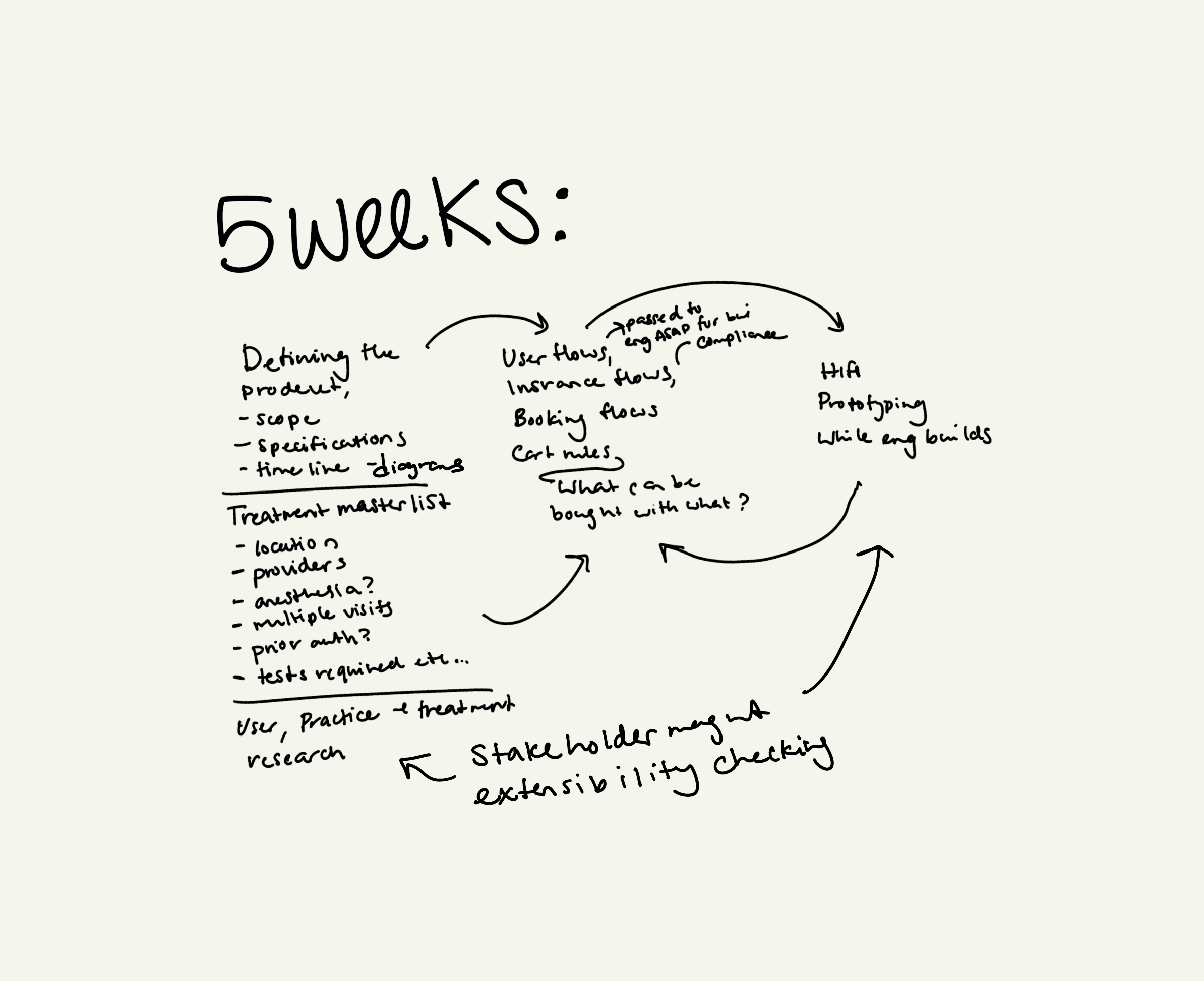



To dos!
Approach and Process
Approach and Process
Rapid Knowledge Acquisition and Strategic Planning
Rapid Knowledge Acquisition and Strategic Planning
The healthcare industry (let alone the billing and insurance!) is notoriously complex, confusing, and often, antiquated. Having known it only the consumer perspective, I had to get up to speed studying healthcare billing systems, insurance models, and treatment types across various medical specialties to understand the pain points and priorities of people simply trying to get treatment, and the providers and administrators trying their best to fight a Sisyphean battle against billing and insurance cycles.
Aside from knowing we wanted a marketplace and the predetermined deadline, we were operating in complete white space. To develop a buildable foundation, I pioneered the creation of comprehensive product specifications, working closely with the Head of Engineering to ensure technical feasibility. I proposed and spearheaded the creation of a comprehensive treatment database in order create content for the marketplace. I collaborated with Growth and Operations teams to develop and implement this system, ensuring we could accurately categorize and present healthcare services while building for future scalability.
I developed detailed user journeys and app maps visualizing the complex pathways users might take through the platform including insurance states, payment states and purchasing rules. I also identified and mapped all aspects treatment product pages to ensure consistency and support the easy entry of treatment information for more straightforward development.
The healthcare industry (let alone the billing and insurance!) is notoriously complex, confusing, and often, antiquated. Having known it only the consumer perspective, I had to get up to speed studying healthcare billing systems, insurance models, and treatment types across various medical specialties to understand the pain points and priorities of people simply trying to get treatment, and the providers and administrators trying their best to fight a Sisyphean battle against billing and insurance cycles.
Aside from knowing we wanted a marketplace and the predetermined deadline, we were operating in complete white space. To develop a buildable foundation, I pioneered the creation of comprehensive product specifications, working closely with the Head of Engineering to ensure technical feasibility. I proposed and spearheaded the creation of a comprehensive treatment database in order create content for the marketplace. I collaborated with Growth and Operations teams to develop and implement this system, ensuring we could accurately categorize and present healthcare services while building for future scalability.
I developed detailed user journeys and app maps visualizing the complex pathways users might take through the platform including insurance states, payment states and purchasing rules. I also identified and mapped all aspects treatment product pages to ensure consistency and support the easy entry of treatment information for more straightforward development.
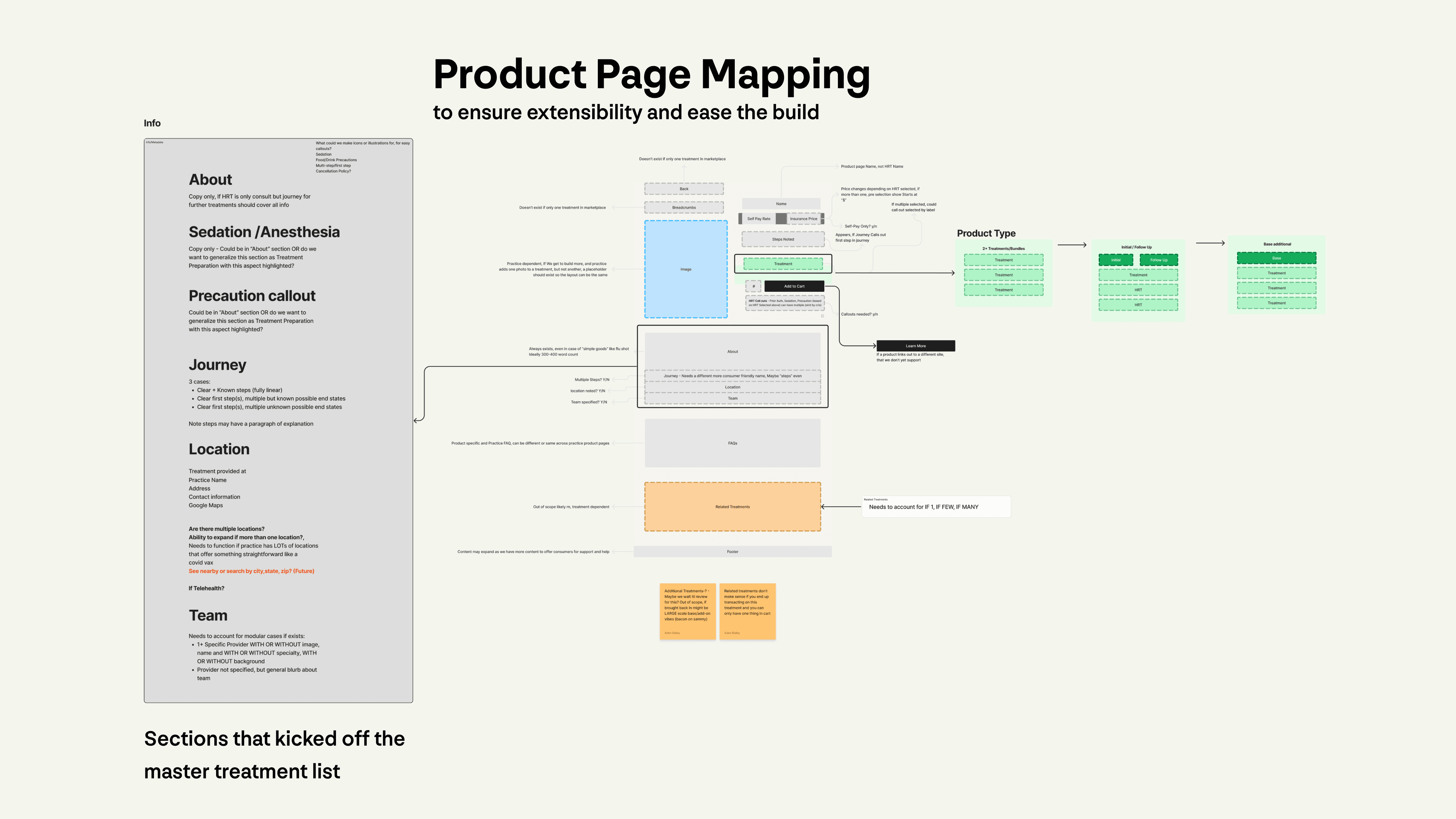



Mapping for product page and treatment master list planning, what aspects would always exist on the page? What is conditional? What are those conditions? The same exercise was done for the marketplace main page.



How the mapping functioned within the product
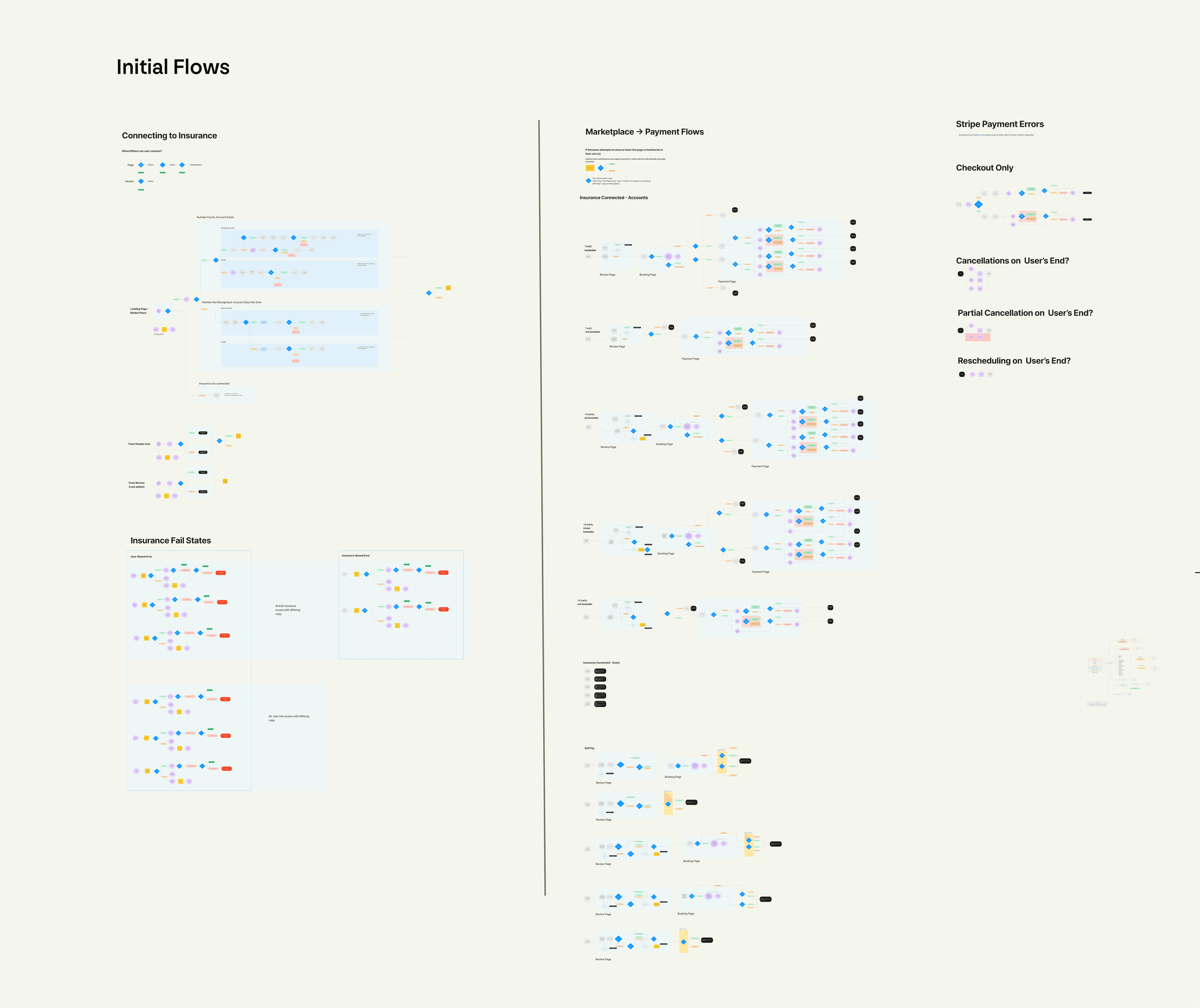



A glance of /just some/ of my flows – shown only for scale
User-Centric Design in a Complex Domain
User-Centric Design in a Complex Domain
Understanding that users would approach the platform with varying levels of healthcare knowledge, I advocated for and designed:
- Clear information hierarchies for diverse treatment types
- Simplified insurance integration flows
- Educational content to support decision-making
- Step-by-step guidance for complex processes
While I proposed a more guided approach to help users understand their care needs before entering the marketplace, stakeholder preferences and tight timeline led to a more direct e-commerce model. I adapted by:
- Incorporating clear service descriptions and prerequisites
- Adding contextual help throughout the booking process
- Designing flexible, extensible information architecture to support future iterations and varying content
- Creating detailed documentation of potential user confusion points for future improvements
Understanding that users would approach the platform with varying levels of healthcare knowledge, I advocated for and designed:
- Clear information hierarchies for diverse treatment types
- Simplified insurance integration flows
- Educational content to support decision-making
- Step-by-step guidance for complex processes
While I proposed a more guided approach to help users understand their care needs before entering the marketplace, stakeholder preferences and tight timeline led to a more direct e-commerce model. I adapted by:
- Incorporating clear service descriptions and prerequisites
- Adding contextual help throughout the booking process
- Designing flexible, extensible information architecture to support future iterations and varying content
- Creating detailed documentation of potential user confusion points for future improvements
Understanding that users would approach the platform with varying levels of healthcare knowledge, I advocated for and designed:
- Clear information hierarchies for diverse treatment types
- Simplified insurance integration flows
- Educational content to support decision-making
- Step-by-step guidance for complex processes
While I proposed a more guided approach to help users understand their care needs before entering the marketplace, stakeholder preferences and tight timeline led to a more direct e-commerce model. I adapted by:
- Incorporating clear service descriptions and prerequisites
- Adding contextual help throughout the booking process
- Designing flexible, extensible information architecture to support future iterations and varying content
- Creating detailed documentation of potential user confusion points for future improvements
Understanding that users would approach the platform with varying levels of healthcare knowledge, I advocated for and designed:
- Clear information hierarchies for diverse treatment types
- Simplified insurance integration flows
- Educational content to support decision-making
- Step-by-step guidance for complex processes
While I proposed a more guided approach to help users understand their care needs before entering the marketplace, stakeholder preferences and tight timeline led to a more direct e-commerce model. I adapted by:
- Incorporating clear service descriptions and prerequisites
- Adding contextual help throughout the booking process
- Designing flexible, extensible information architecture to support future iterations and varying content
- Creating detailed documentation of potential user confusion points for future improvements
Rapid Prototyping and Iterative Design
Rapid Prototyping and Iterative Design
I created many low-fidelity wireframes to rapidly ideate on different marketplace layouts and user flows. This was followed by mid-fidelity prototypes testing key user journeys and high-fidelity, interactive prototypes for stakeholder reviews and preliminary testing (unfortunately not shown here due to partner sharing constraints).
Key prototypes explored practice storefront layouts, mobile buying mechanisms, insurance integration flows, and booking.
I created many low-fidelity wireframes to rapidly ideate on different marketplace layouts and user flows. This was followed by mid-fidelity prototypes testing key user journeys and high-fidelity, interactive prototypes for stakeholder reviews and preliminary testing (unfortunately not shown here due to partner sharing constraints).
Key prototypes explored practice storefront layouts, mobile buying mechanisms, insurance integration flows, and booking.
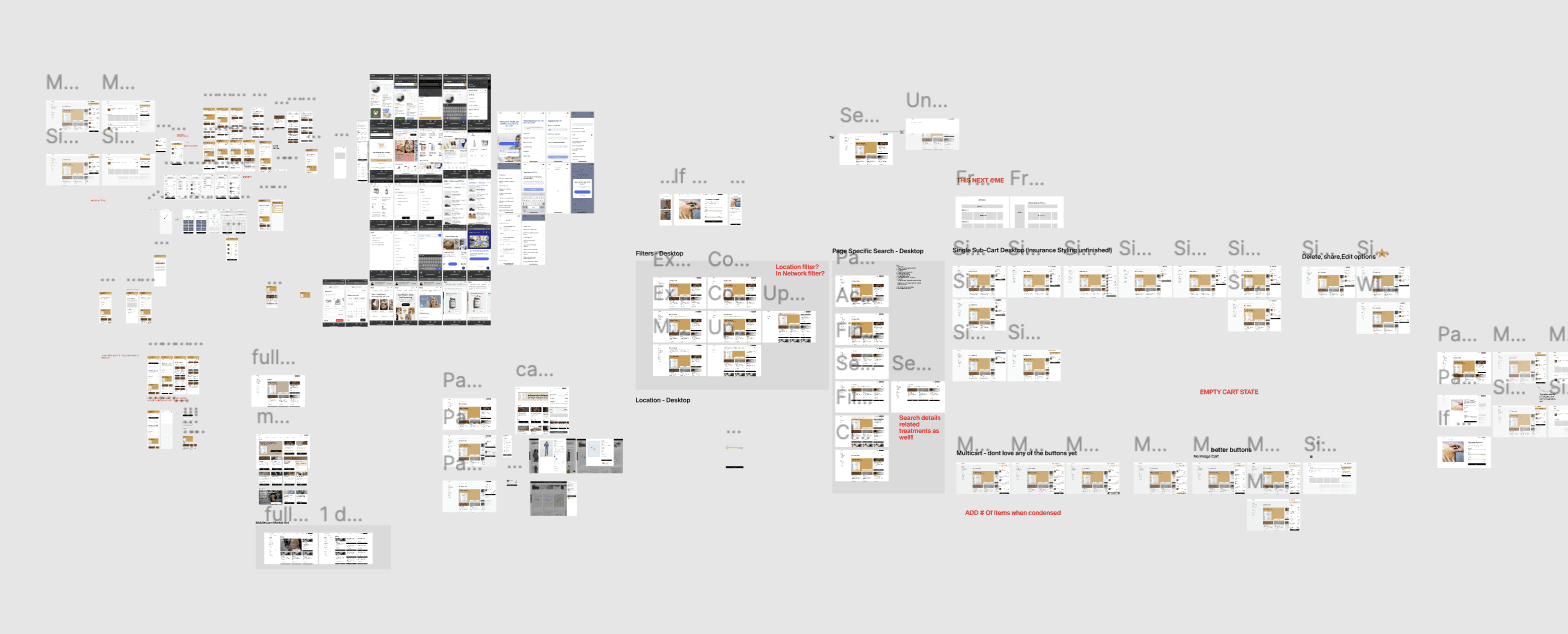



Warning: Figma gore!
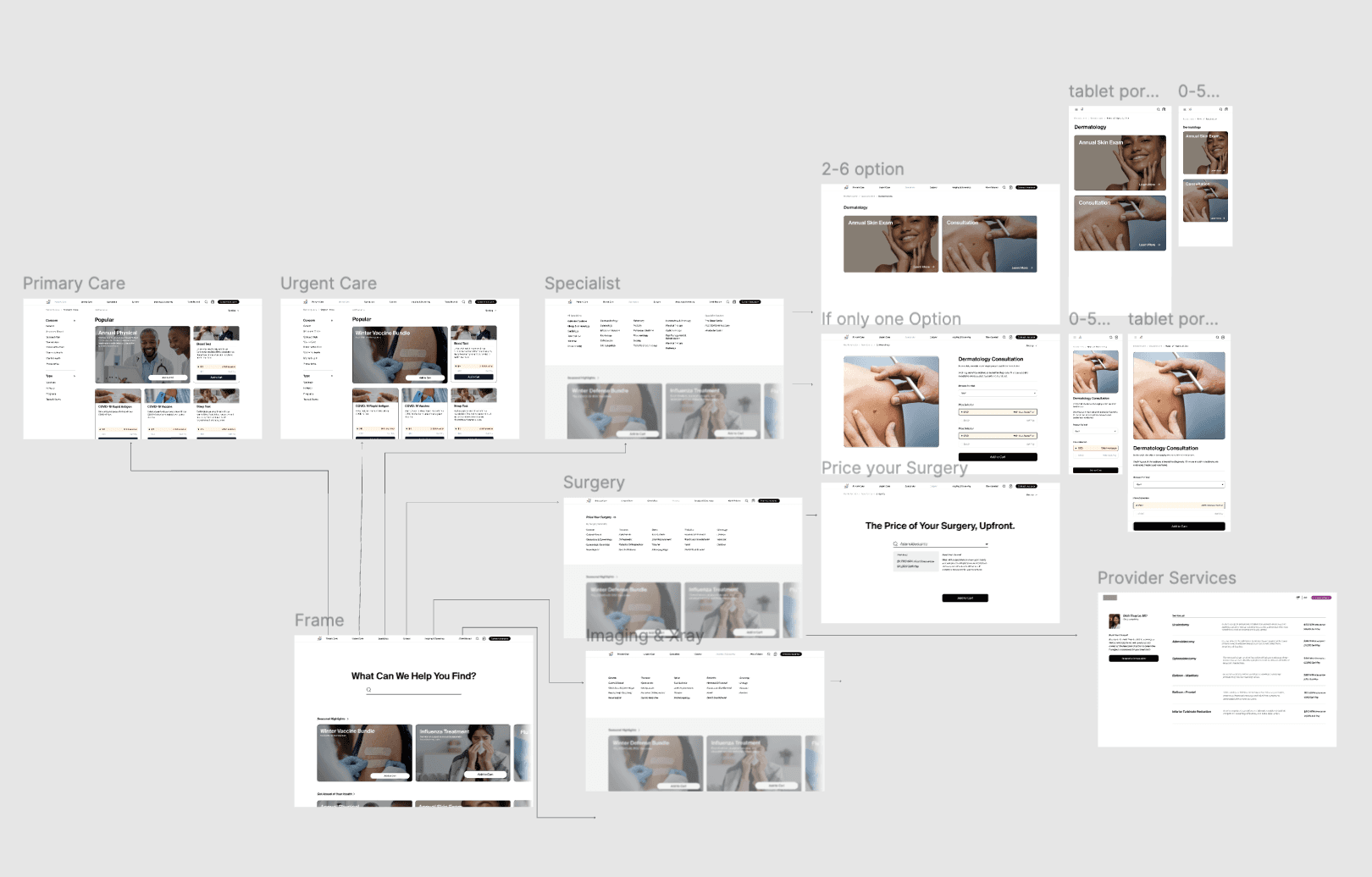



Figuring out how things differ based on practice or treatment type
Data-Driven Design and User Research
Data-Driven Design and User Research
With timeline constraints, I turned to many leading journals in UX research, such as the Neilson Norman group to examine existing data on online shopping experiences. Additionally, we conducted focused user research:
- Pre-launch provider and administrator interviews to understand workflow needs
- Shadowing of 5 practices
- Post-launch patient feedback
- A/B testing of critical user flows
- Continuous monitoring of user behavior patterns through data dog
With timeline constraints, I turned to many leading journals in UX research, such as the Neilson Norman group to examine existing data on online shopping experiences. Additionally, we conducted focused user research:
- Pre-launch provider and administrator interviews to understand workflow needs
- Shadowing of 5 practices
- Post-launch patient feedback
- A/B testing of critical user flows
- Continuous monitoring of user behavior patterns through data dog
Agile Collaboration and Iterative Development
Agile Collaboration and Iterative Development
I worked hand-in-hand with the development team, providing designs in real-time as they built the platform and ensuring extensibility in the build and treatment organization with the Head of Engineering.
This parallel process demanded:
- Rapid iteration and problem-solving as technical constraints emerged
- Clear, constant communication with cross-functional teams
- Flexibility to refine and adapt designs based on ongoing feedback and development progress
I also worked closely with the Head of Growth and Head of Finance on both partner and business strategy, while meeting consistently with stakeholders.
By maintaining an agile, collaborative approach, we were able to overcome numerous obstacles and keep the project on track despite the tight timeline.
I worked hand-in-hand with the development team, providing designs in real-time as they built the platform and ensuring extensibility in the build and treatment organization with the Head of Engineering.
This parallel process demanded:
- Rapid iteration and problem-solving as technical constraints emerged
- Clear, constant communication with cross-functional teams
- Flexibility to refine and adapt designs based on ongoing feedback and development progress
I also worked closely with the Head of Growth and Head of Finance on both partner and business strategy, while meeting consistently with stakeholders.
By maintaining an agile, collaborative approach, we were able to overcome numerous obstacles and keep the project on track despite the tight timeline.
Outcomes and Impact
Outcomes and Impact
The project successfully launched within the prescribed timeline, delivering:
- A HIPAA-compliant marketplace platform including an extensible practice page, product pages, insurance connection, checkout and booking.
- Secure insurance integration
- 175% increase in direct bookings at pilot location
- Flexible design system for future scaling
The project successfully launched within the prescribed timeline, delivering:
- A HIPAA-compliant marketplace platform including an extensible practice page, product pages, insurance connection, checkout and booking.
- Secure insurance integration
- 175% increase in direct bookings at pilot location
- Flexible design system for future scaling








Challenges and Insights
Challenges and Insights
Early in the project, I anticipated that users might be confused about purchasing healthcare services through an e-commerce platform and that insurance integration would be a significant usability and learning challenge.
These concerns proved valid in our post-launch research, where users expressed initial hesitation about purchasing healthcare services online, and found the insurance integration and purchasing process confusing.
Given our 5-week sprint timeline, I had to make strategic decisions about what we could feasibly implement while still delivering a functional product. I would love to pursue a more guided approach in the future—helping users understand what care they needed before presenting them with a marketplace—would ultimately provide a better user experience, we had to focus on creating the best possible solution within our immediate constraints.
Early in the project, I anticipated that users might be confused about purchasing healthcare services through an e-commerce platform and that insurance integration would be a significant usability and learning challenge.
These concerns proved valid in our post-launch research, where users expressed initial hesitation about purchasing healthcare services online, and found the insurance integration and purchasing process confusing.
Given our 5-week sprint timeline, I had to make strategic decisions about what we could feasibly implement while still delivering a functional product. I would love to pursue a more guided approach in the future—helping users understand what care they needed before presenting them with a marketplace—would ultimately provide a better user experience, we had to focus on creating the best possible solution within our immediate constraints.
Next Steps
Next Steps
Based on our learnings and my initial concerns, I developed several proposals for future improvements.
The most significant would be implementing a guided discovery approach, where users are led through a series of questions to help them understand their care needs before entering the marketplace environment.
This would help address the hesitation around online healthcare purchasing by creating a more conversational entry point, providing more context to the user.
Additional proposed improvements include:
- Implementing an AI integration to aid with user health education and finding the best treatment match based on the care they need
- A comprehensive UI refresh focusing on clarity and trust-building elements and delight in the experience
- Creating a more intuitive, step-by-step flow for insurance integration
- Developing a concern-based user journey to better guide users through the healthcare shopping process
- Implementing clearer communication about platform capabilities
- Developing an onboarding flow to educate first-time users about the benefits and security of online healthcare booking
- Creating more detailed provider profiles with credentials and patient reviews
- Implementing a more flexible backend for providers to customize their service listings
- Full account management and creation across all practices that ingrate with the product
Based on our learnings and my initial concerns, I developed several proposals for future improvements.
The most significant would be implementing a guided discovery approach, where users are led through a series of questions to help them understand their care needs before entering the marketplace environment.
This would help address the hesitation around online healthcare purchasing by creating a more conversational entry point, providing more context to the user.
Additional proposed improvements include:
- Implementing an AI integration to aid with user health education and finding the best treatment match based on the care they need
- A comprehensive UI refresh focusing on clarity and trust-building elements and delight in the experience
- Creating a more intuitive, step-by-step flow for insurance integration
- Developing a concern-based user journey to better guide users through the healthcare shopping process
- Implementing clearer communication about platform capabilities
- Developing an onboarding flow to educate first-time users about the benefits and security of online healthcare booking
- Creating more detailed provider profiles with credentials and patient reviews
- Implementing a more flexible backend for providers to customize their service listings
- Full account management and creation across all practices that ingrate with the product
Finally
Finally
Despite aggressive timelines and competing priorities, I successfully delivered a platform that can take on a huge range of practices and treatments. I advocated for users while adapting to business constraints, and new territories, resulting in a solution that laid the groundwork for future improvements in healthcare access.
Despite aggressive timelines and competing priorities, I successfully delivered a platform that can take on a huge range of practices and treatments. I advocated for users while adapting to business constraints, and new territories, resulting in a solution that laid the groundwork for future improvements in healthcare access.